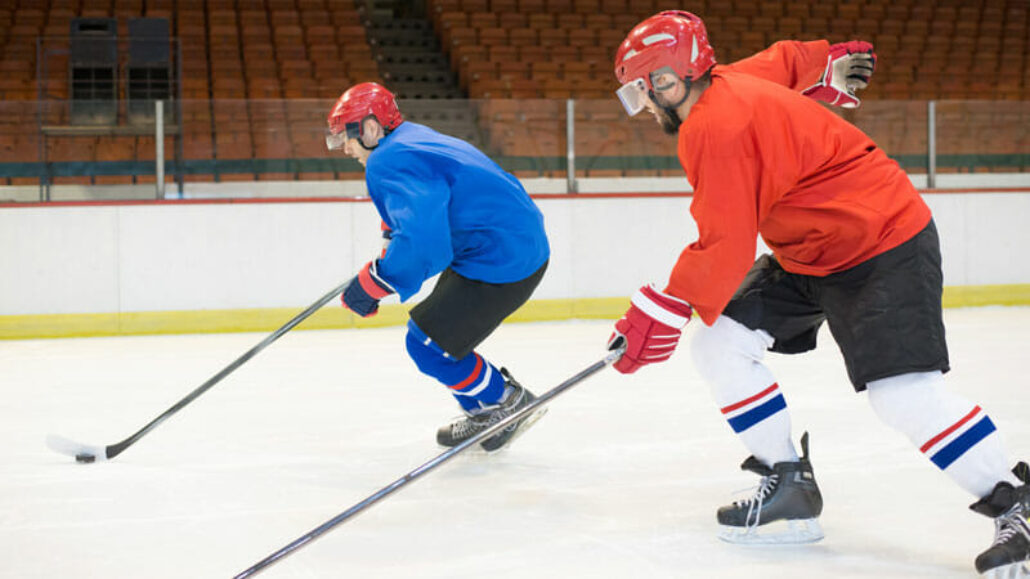Summit hand and upper extremity surgeon — and elite collegiate hockey player — J.P. Delaney, M.D., discusses the most common hand and wrist injuries among hockey players.
Hockey is beloved across Minnesota for its combination of athleticism, strategy, and fast‐paced action. But hockey players can also be prone to injuries in the hands and wrists. What are the most common hockey hand and wrist injuries, and how can hockey players prevent them?
Dr. Delaney knows hockey. After playing the sport throughout high school in Rochester, Minnesota, he played Division I hockey at Colorado College. Although his focus shifted as he went to medical school and pursued a career in orthopedic surgery, Dr. Delaney continued to play at the recreational level.
Most common hockey hand and wrist injuries
“The most common hand and wrist injuries for hockey players are trauma‐related,” Dr. Delaney said. There are lots of ways that a player can injure hands, wrists, or fingers, from contact with the boards, to contact with another player or the puck. Common hockey hand and wrist injuries include:
- A range of finger and thumb injuries, most often from impact
- Hand fractures
- Hand ligament injuries
- Wrist fractures — the most common in younger players are distal radius fractures, while adolescents often experience scaphoid fractures
Finger injuries can happen when a finger or thumb bends the wrong way, injuring or rupturing a ligament. “These can often be treated without surgery, but it typically requires immobilization or bracing,” Dr. Delaney said. The most common ligament injuries — sprains to the ligaments around the wrist — generally respond well to conservative management.
Wrist fractures, conversely, can often be misdiagnosed. “Scaphoid fractures in particular are frequently mistaken for a wrist sprain, because often the symptoms include vague wrist pain,” Dr. Delaney said. “But unlike a wrist sprain, it doesn’t go away with conservative treatment.”
When to seek treatment for hockey hand and wrist injuries
Sometimes, hockey players wait weeks or months before seeing a doctor about the pain, a tactic that can put their long‐term joint health in jeopardy. “It’s much easier to treat these injuries, with more reliable outcomes, when they are diagnosed early and treated appropriately,” Dr. Delaney said.
Although it’s hard to avoid all injuries — especially if you’re an avid hockey player — Dr. Delaney’s advice is simple: don’t wait. A player with severe pain, significant swelling, or bruising should see an orthopedic specialist right away. If the pain is mild or moderate, it’s okay to try conservative measures, including bracing, taping, RICE, and anti‐inflammatories. “If it’s not better in a week or two, however, they need to come in,” Dr. Delaney said.
At Summit, our team of orthopedic specialists can help you get back on the ice as quickly as possible, taking a conservative approach to treatment and only performing surgery if necessary.
Summit Orthopedics provides personalized hand and wrist expertise
The function of our hands is integrated through our wrists and arms to our shoulders; a problem anywhere along our arm may have a significant impact on hand function and quality of life. If you experience an injury or uncomfortable symptoms, our fellowship-trained hand and wrist surgeons are here to help. Summit physicians receive the highest levels of training and exclusively provide individualized care for conditions of the hand, wrist, and elbow.
Start your journey to better function and less pain. Find your hand expert, request an appointment online, or call us at (651) 968–5201 to schedule a consultation.
Summit has convenient locations across the Minneapolis-St. Paul metro area, serving Minnesota and western Wisconsin. We have state-of-the-art centers for comprehensive orthopedic care in Eagan, MN, Plymouth, MN, Vadnais Heights, MN, and Woodbury, MN, as well as additional community clinics throughout the metro and southern Minnesota.
More resources for you
- Learn about wrist fracture treatments.
- Trigger Finger Treatments
- Causes of Trigger Finger
- Hockey Strengthening Exercises to try Before You Head Out on the Ice

